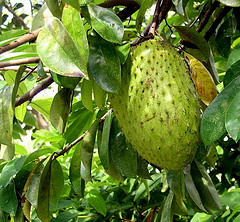 |
| Source: http://www.alkaline-water-site.com/Guyabano.html |
About the Guyabano
The heart shaped / oblong Guyabano fruit has a dark green, leatherly abd soike-like skin that measures from 8 to 12 inches long and can weigh up to 2.5 kilos. The creamy and delectable flesh contains from 60 to 100 black-brown seed that are indigestible and non-edible. The Guyabano tree is relatively small. It usually grows from 8 feet to less than 20 feet high and is sensitive to very cold temperatures. The Guyabano tree requires a lot of water, warmth and humidity and is usually grown in the tropics. It is cultivated commercially in Central & South America, West Africa, Asia and South Florida in limited numbers.
Products made from Guyabano tree
Aside from being eaten raw, the guyabano fruit is processed into candies, tarts, shakes, ice-cream, sherbets, beverages. The leaves are made into tea and the leaves and stem are made into Guyabano vitamins and supplements.
Medicinal Uses of Guyabano
Medicinal Uses of Guyabano
Guyabano has been used as folkloric herbal medicine in many regions thought the world. It is considered to be antispasmodic, sudorific and emetic. A decoction (boiling in water) of guyabano leaves is used to kill bedbugs and head lice.
To reduce fever, a decoction of leaves can be taken internally or the leaves added to bathing water also has the same effect. The crushed fresh leaves are also applied on skin eruptions for faster healing. A poultice of young guyabano leaves is applied on the skin to alleviate rheumatism and other skin infections like eczema. Applied during the healing of wounds, this can result in less or no skin scars. The decoction can also be used as a wet compress on swollen feet and other inflammations.
The juice of the fruit is taken orally as a herbal remedy for urethritis, haematuria and liver ailments.
Studies are underway by leading medical institutes, universities and pharmaceutical companies of the healing properties of guyabano against cancers. Initial findings show that certain compounds and chemicals extracted from guyabano leaves, seeds, fruit and bark appear to kill cancer cells while leaving normal cells remain unaffected.
To reduce fever, a decoction of leaves can be taken internally or the leaves added to bathing water also has the same effect. The crushed fresh leaves are also applied on skin eruptions for faster healing. A poultice of young guyabano leaves is applied on the skin to alleviate rheumatism and other skin infections like eczema. Applied during the healing of wounds, this can result in less or no skin scars. The decoction can also be used as a wet compress on swollen feet and other inflammations.
The juice of the fruit is taken orally as a herbal remedy for urethritis, haematuria and liver ailments.
Studies are underway by leading medical institutes, universities and pharmaceutical companies of the healing properties of guyabano against cancers. Initial findings show that certain compounds and chemicals extracted from guyabano leaves, seeds, fruit and bark appear to kill cancer cells while leaving normal cells remain unaffected.
Source:http://guyabano.com/Nutritional_Value.html
The Leader
ACTRESS @ CELEBRETIES HOT PHOTOS
Young and Adult Sexual Reprouctive Health
Organic Farming
No comments:
Post a Comment